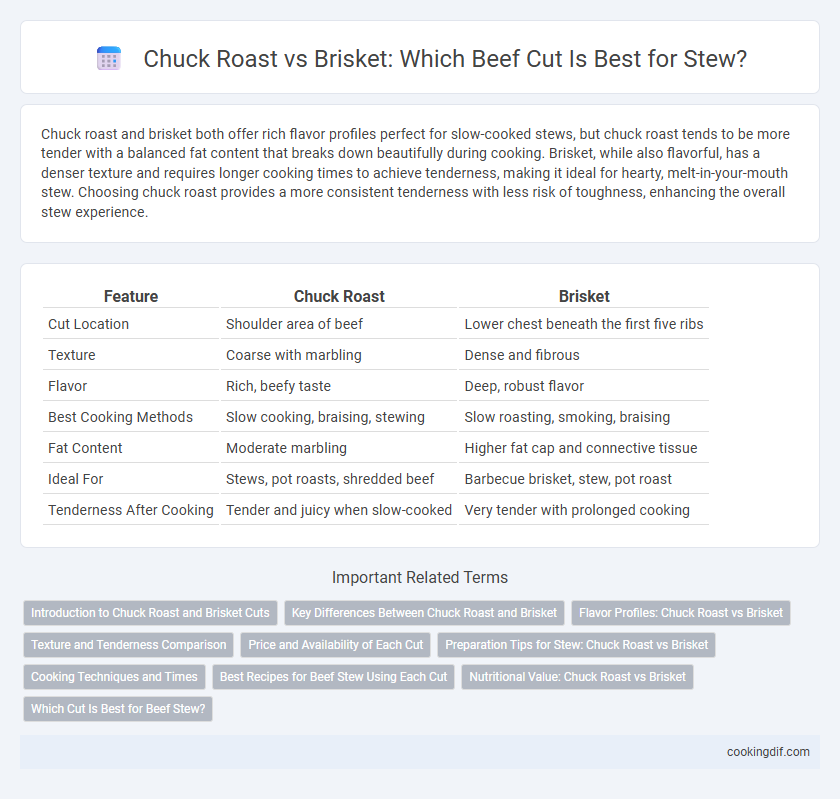Chuck roast and brisket both offer rich flavor profiles perfect for slow-cooked stews, but chuck roast tends to be more tender with a balanced fat content that breaks down beautifully during cooking. Brisket, while also flavorful, has a denser texture and requires longer cooking times to achieve tenderness, making it ideal for hearty, melt-in-your-mouth stew. Choosing chuck roast provides a more consistent tenderness with less risk of toughness, enhancing the overall stew experience.
Table of Comparison
| Feature | Chuck Roast | Brisket |
|---|---|---|
| Cut Location | Shoulder area of beef | Lower chest beneath the first five ribs |
| Texture | Coarse with marbling | Dense and fibrous |
| Flavor | Rich, beefy taste | Deep, robust flavor |
| Best Cooking Methods | Slow cooking, braising, stewing | Slow roasting, smoking, braising |
| Fat Content | Moderate marbling | Higher fat cap and connective tissue |
| Ideal For | Stews, pot roasts, shredded beef | Barbecue brisket, stew, pot roast |
| Tenderness After Cooking | Tender and juicy when slow-cooked | Very tender with prolonged cooking |
Introduction to Chuck Roast and Brisket Cuts
Chuck roast and brisket are two popular beef cuts commonly used in stews, prized for their rich flavor and tenderness when slow-cooked. Chuck roast comes from the shoulder area, offering a well-marbled, moderately tough cut that breaks down beautifully during long cooking times. Brisket, originating from the chest, is leaner but requires slow, moist heat to transform into a tender, flavorful addition to hearty stews.
Key Differences Between Chuck Roast and Brisket
Chuck roast has more marbling and connective tissue, making it ideal for slow-cooked stews with rich, tender results. Brisket is leaner and denser, requiring low and slow cooking methods to break down its fibrous texture. Both cuts benefit from slow cooking but differ in fat content and muscle structure, influencing flavor and tenderness in stew recipes.
Flavor Profiles: Chuck Roast vs Brisket
Chuck roast offers a rich, beefy flavor with a slightly more intense taste due to its higher fat content and marbling, making it ideal for slow-cooked stews. Brisket features a deeper, more complex flavor profile with smoky, slightly sweet undertones that develop during long cooking, ideal for braising or low and slow methods. Both cuts break down into tender, flavorful meat but differ in texture and fat distribution, influencing the overall stew experience.
Texture and Tenderness Comparison
Chuck roast offers a coarse texture with moderate marbling, resulting in a tender yet slightly chewy bite when slow-cooked, making it ideal for stews that require prolonged simmering. Brisket has a denser, fibrous texture with higher collagen content, which transforms into succulent tenderness after extended cooking, providing a melt-in-the-mouth experience perfect for rich, hearty stews. Choosing between chuck roast and brisket depends on the desired balance of tenderness and texture, with chuck delivering a more robust chew and brisket offering unparalleled softness.
Price and Availability of Each Cut
Chuck roast is generally more affordable and widely available in most grocery stores compared to brisket, making it a budget-friendly option for beef stew. Brisket tends to be pricier due to its popularity in barbecue and slow-cooking recipes, and its availability may be limited outside specialty or butcher shops. Choosing chuck roast ensures easier access and cost savings without sacrificing flavor in hearty stew dishes.
Preparation Tips for Stew: Chuck Roast vs Brisket
Chuck roast is ideal for stew due to its marbling and connective tissue, which break down into tender, flavorful meat when slow-cooked. Brisket requires longer cooking times at low temperatures to achieve tenderness, making it suitable for extended stewing or braising. For optimal results, brown chuck roast before stewing to enhance flavor, while trimming excess fat from brisket helps prevent grease-heavy stew.
Cooking Techniques and Times
Chuck roast requires slow cooking methods like braising or stewing for 2.5 to 3 hours to break down its connective tissue, resulting in tender, flavorful beef. Brisket, being tougher, benefits from low-and-slow cooking techniques such as smoking or slow roasting for 6 to 8 hours to achieve a melt-in-your-mouth texture. Both cuts perform well in stews, but chuck roast offers a richer, more uniform tenderness due to its higher fat content and marbling.
Best Recipes for Beef Stew Using Each Cut
Chuck roast offers rich marbling and tenderness after slow cooking, making it ideal for hearty, flavorful beef stew recipes with deeply developed savory profiles. Brisket, with its tougher texture, becomes succulent when braised slowly, lending a distinctive beefy flavor and gelatinous texture that enriches stew broths. Use chuck roast for classic beef stew recipes featuring chunky vegetables, while brisket excels in slow-simmered stews requiring long cooking times to unlock its full tenderness and taste.
Nutritional Value: Chuck Roast vs Brisket
Chuck roast contains approximately 250 calories, 20 grams of protein, and 18 grams of fat per 4-ounce serving, providing a rich source of iron and zinc. Brisket offers around 220 calories, 19 grams of protein, and 15 grams of fat per 4-ounce portion, making it slightly leaner but still nutrient-dense with similar levels of B vitamins. Both cuts deliver essential nutrients valuable for muscle maintenance and energy, but brisket's lower fat content makes it a marginally healthier option in terms of calorie density.
Which Cut Is Best for Beef Stew?
Chuck roast is the best cut for beef stew due to its balance of marbling, collagen, and fat, which breaks down during slow cooking to create tender, flavorful meat. Brisket has a denser texture and higher fat content, making it less ideal for stew but better suited for smoking or braising. Choosing chuck roast results in a rich, succulent beef stew with well-rendered gelatin and a hearty mouthfeel.
Chuck Roast vs Brisket for beef cut Infographic

 cookingdif.com
cookingdif.com